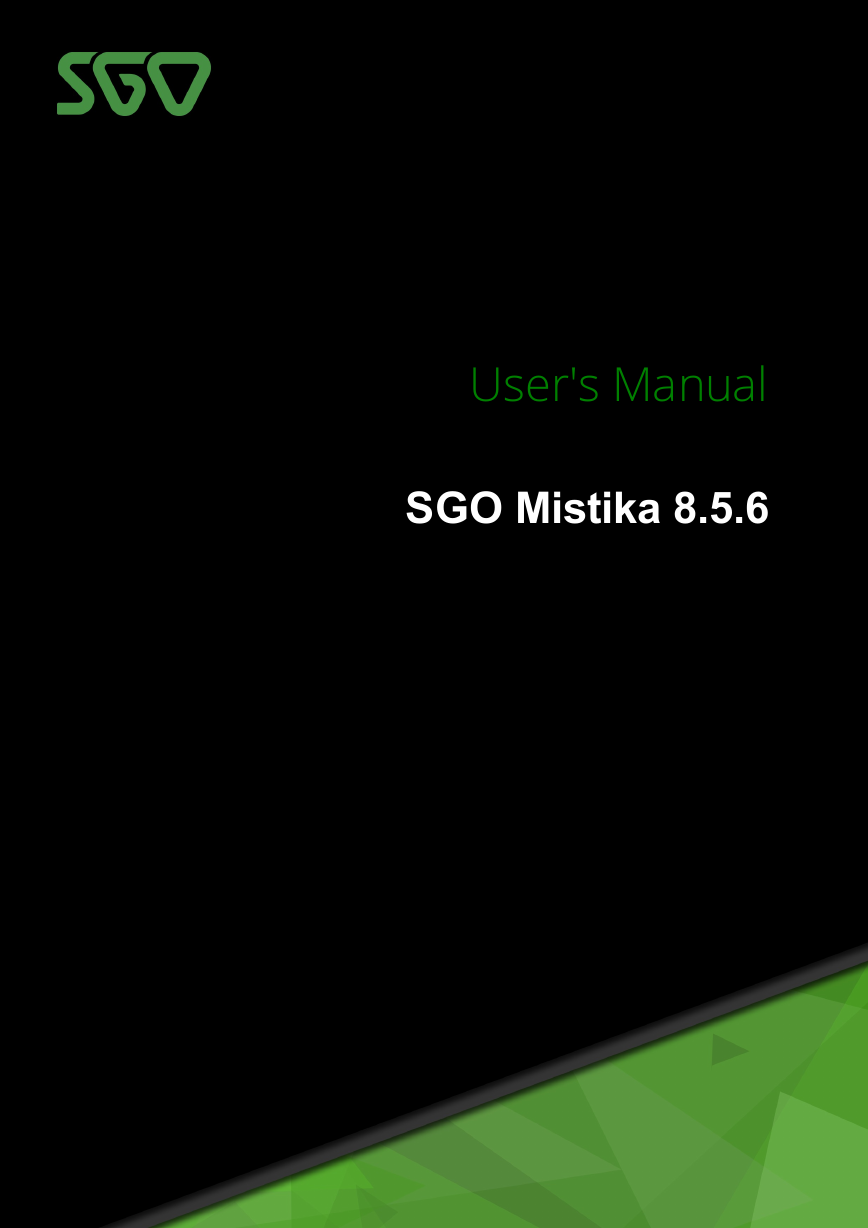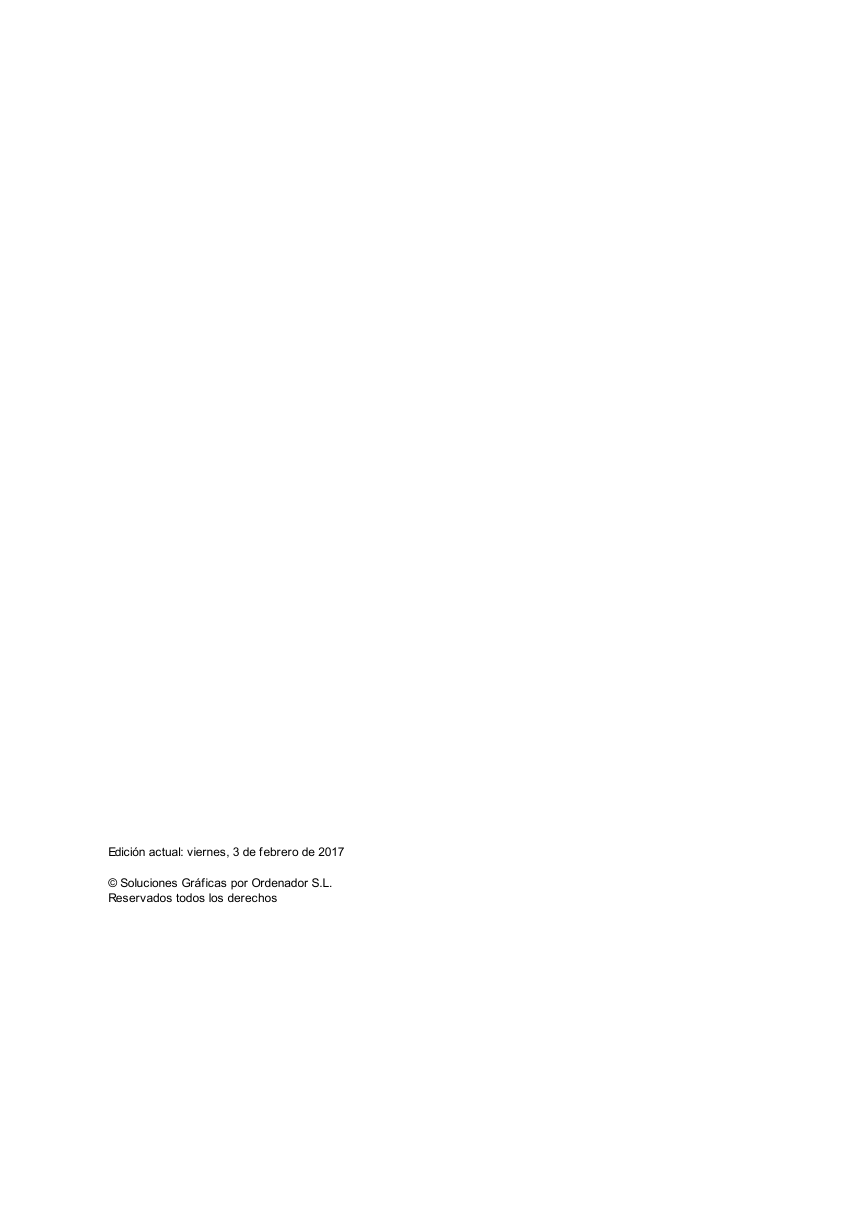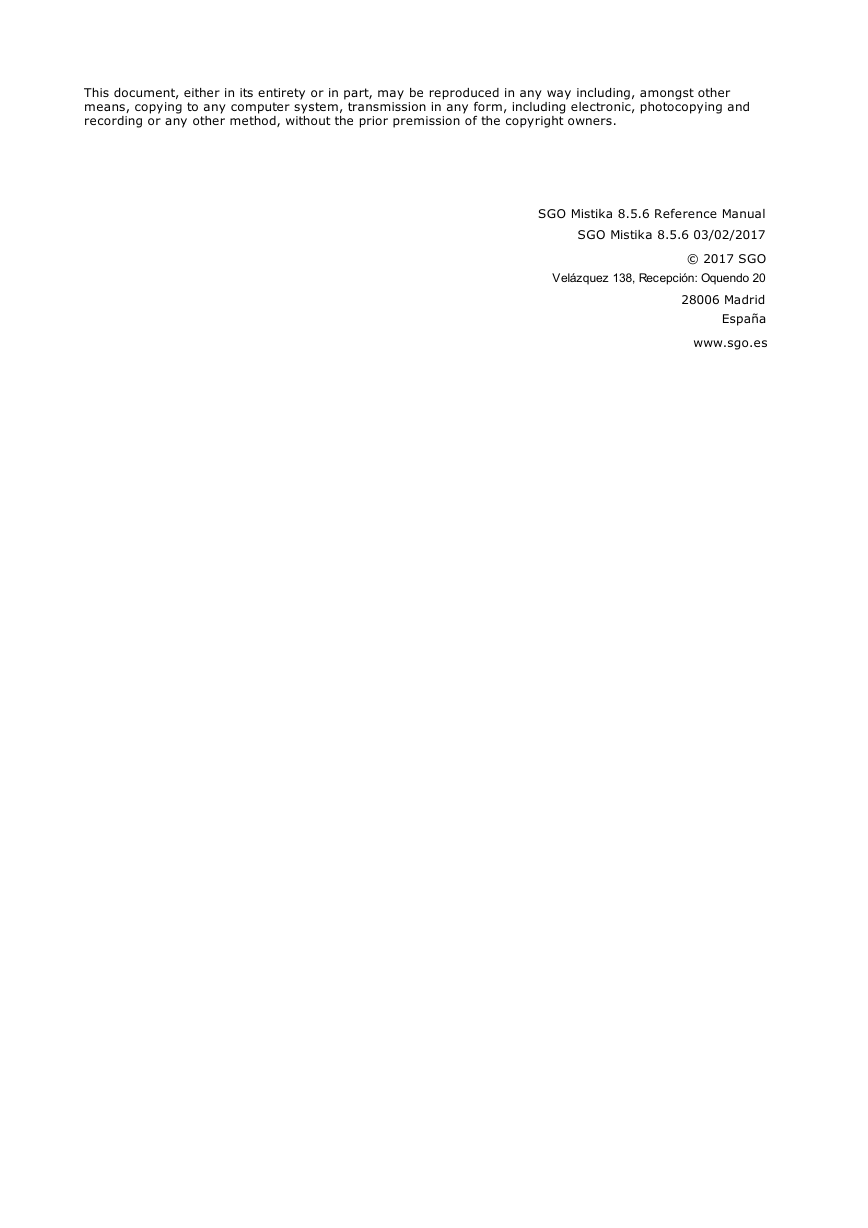Introduction to SGO Mistika
Introduction to SGO Mistika
The all-in-one solution for top-of-the-range post-production
Any kind of job in all formats
Fully open and integrable in any infrastructure
Intuitive and integrated interface for immediate results
Taking care of image quality
Extreme features
Optimizing costs
Conventions used in this document
Conventions used in this document
References to files
References to keys
References to documents
References to menus, panels and buttons
References to literals
Parameter Description
Basic concepts
Working environment
Software Installation
Starting a session
Ending a session
The desktop and its tools
Accessing Mistika
The desktop icon
Autodetection of Layout for the work resolution
Selection of elements
Data fields
Mistika’s buttons
Keyboard Shortcuts (edition)
Scribe (Gestural commands)
Activating Scribe
Using Scribe with the digitising tablet
Using Scribe with the mouse
Symbol library
Image formats and color spaces in Mistika
Preferred realtime formats: Mistika .JS y .DPX
Compression vs No compression
Color spaces
YUV 4:2:2
Illegal colors and out-of-range workflows
Linear RGB 4:4:4 8 bits
Linear RGBA 4:4:4:4 8 bits
Logarithmic RGB 4:4:4 10 bits
HDR
XYZ
Transformations between linear and logarithmic colour spaces
Global production workflow and two-way conforming
Example of global workflow
Mistika SETUP (mConfig)
Installing the Mistika system
Mistika Setup configuration parameters
General
General
File Paths
File Paths
Predefined storage paths (Path Builder)
Path Builder
Cache files and proxies
Obsolete relative paths for backward compatibility
Master Format
Master Format
Video board format (DVS Centaurus and Atomix)
Other Video Settings
Codecs
FFMPEG Codecs
RED
Performance Options
Batch Manager
Batch Manager
Batch Manager GUI
Mail Notifications
TOTEM
Totem Manager
Interface
Interface
Tablet Device options
Title Options
Render Interface
License
Licence
SNFS© S.A.N.
SNFS©
SNFS© diagnostic and repair tools
Tangent Devices
CP200
Trackerballs (CP200-BK)
Knobs(CP200-K)
Transport & Selection (CP200-TS)
Common Network parameters
TANGENT ELEMENT USB SURFACES
Other Settings
Precision
3D LUTS
Calibration tools
LightSpace CMS
Select Default 3D LUT
Utils
Utils
Dailies logo and burn TC
After Sripts Data
The Interface
Starting up Mistika
The interface structure
Node Graph Editor
timeSpace
Editing and compositing workflows
Elements of the timeSpace
Grid
Cursor
Monitor
Play Marks
Edit Marks
TC Mark
User Marks
Vumeters
Notes & Graffiti
Individual Clips
Image clips
Audio clips
Parameters
Audio mixes
Mixed clips
Group clips
Common Group characteristics
Navigation
Group in Normal state
Saving changes when exiting a Normal group
Groups in Timewarp state
Parameters
Timewarp
Optical Flow
Saving changes when exiting a Timewarp group
Group in Template state
Saving changes when exiting a Template group
Effect clips
Common characteristics of effects clips
Order of effect inputs
Manipulation of an effect clip with scope
The Alpha Channel
timeSpace tools
Info Bar
TC Slider
Offset controls
Zoom Controls
Quick Access
History
Edit
Pack
Navigation
Align
Prev/Next
Edit Marks
Shuttle
Play
Play Marks
Save
Render
Mute
Overview
Dashboard
Project
Commands
Backing-up projects
Backup of Media to video
Directories
Creating backup
Playout procedure
Delete procedure
Restore procedure
Conclusion
Backup of Metadata and non-standard Media
Media
Interface panels
Directories structure
BACKUP_3
DATA_3
EXT_MEDIA_3
IMPORT_3
OUTPUT_3
PRESETS_3
PRIVATE_3
Top Menu
Filter Box
Browsers
Bookmarks
Properties
Using double-click with files
Compatible formats
Conform
Conforming EDLs
Conforming modes
Tapes
Mistika Clips
AAF
XML
Edit
Classic NLE editing
Three point editing
Four point editing
Active track
Direct editing
Clip position
Trimming
Local Trimming
Shifting
Duplicating clips
Advanced Editing
Edit
Active
Commands
Attributes
Transitions/Mix
I/O
Description and parameters
Fade Up
Fade Down
Fade from Color
Fade to Color
Non Linear-M
Multiple Mix
Alpha Mix
Page Turn
Transitions/Wipes
I/O
Parameters
Wipe Stripe
Mask_1
Wipe Circle
Mask_1
Use and Comments
Subtitle
Split
Duplicate
Calc
Position
Duration
Move
Shift
Trim Mode
Animation
Trim Head
Trim Tail
Reel TC
Cursor/Select
Cursor/Notes
Cursor/Group Layers
User Marks
Global
Time
Macros
Playback Cache
Attributes
Clip Name
Fields
Timeline
Trim Remnant
Source Info
Comments
Extras
Setup
Timeline View
Timeline Monitor
Timeline Save
Playback Cache
Edit
Transition effects defaults
Interface
FX
Curves
Curves
Direct editing method
Viewing options
Curves Tabs
Points
Curve
Block
Time
Scale
VTR
VTR Capture
Tracks
Control of clips
Time Codes
Comments
Format
Perform
Batch Capture
After Capture
Last Captured Clips
Capture by firewire
Troubleshooting video capture and playout problems
VTR Play Out
Tracks
Time Line
Tape Positions
Tape transfer mode
Perform
VTR Setup
Audio
Mixer
Router
Setup
Tools
Change Audio Ratio
Change Audio Speed
Split Audio Channels
Change Audio Bitrate
Status
Optimizing volume for best audio quality
Output
Render
Channels
Setup
Full Res Image
Proxy Image
Sound File
Render Resolution and Framing
Render Fields Mode
Render 3:2 Pulldown Mode
Render Segments Mode
Split To Segments options
Sequence Render Options
Render Stereo 3D Mode
Render Name
Virtual Slate
Do Render
Script to run after the render
Flush Mistika Image Cache
Syntax for render script definition
Running render from a command-line Shell
Export EDL
Commands
Export EDL2
Commands_2
DCP
DCP Name
MXF Creation
XML Creation
KDM Creation
Totem
Overlay Burn
Commands
Monitor Display
Access
Source Monitor
Commands
Timecode command
Overwrite / Insert / Paste On Top
Editing marks
Playback controls
Slider
Menu / Maximize
Record Monitor
Commands
Option menu
Resolution button
Burn button
Interlaced Display
Show Alpha
Audio Wave
Live Video
Stereo Mode
Ratio Cor.
Save Image
Follow Dial
Center Monitor
Safe Area / Grid
Zoom
Node Graph Editor
Types of nodes
Toolbar
Organization of nodes
Basic operations with nodes
Groups of nodes
Time and Trim
Viewing nodes
Keyboard commands
Basic functions
Visual Editor
Canvas
Toggles
FX Presets
Commands
Eval Tree
Storyboard
Scopes
Snapshot
Depth Graph
Keygrame Graph
Zoom Controls
Display Filters Shortcuts
Keyframe Slider
Quick Access
Timeline Shuttle
Bring
Gang
Composer Shuttle
Options
Parameters
Dashboard
Set Color
Pick Key
Framing
Canvas
Dashboard
Rescale
Auto Resize
Set Crop
Source Size
Result Size
User Crop in Pixels
User Resize and Offset in Pixels
Stereo3D
2D
Comp3D
Canvas Manipulators
Dashboard Manipulators
Manip Axis
Manip Cam / View
Axis Constrain
View
Display
Aspect
Selection
Color Grade
Open FX
Multilayer
Shapes
Create
Points Softness
Points Mode
Points Reset
Shape Priority
Animation
Edit
Effect Input Alpha
Shape Combine
Default Shape Softnes Width
Shape Parameters
Detect scenes
Paint
Title
Warper
Tracking
Tracking Editor
Canvas
Dashboard
Tracking Ranges
Trackers
Clear Ranges
Search Zone
Apply To
Path
Do Tracking
Remove Points
Apply
Shape Mode
Shape Track
Setup
Display
Display Filters
FX
Mistika FX
Compose
Comp3D
I/O
Parameters
Options
Background
Shadow
Camera
Ambient
Light_1
Axis_1
Axis_2
Layer_1
Transform
Attributes
Deform
DispMap
Torus
Wave
Crop
Corner
Use and Comments
HaloComp
I/O
Parameters
Use and Comments
Feedback
I/O
Parameters
Use and Comments
Scope
I/O
Parameters
Use and Comments
Dummy Clip
Dummy Comp
I/O
Parameters
Use and Comments
Boolean
Channels
Clip naming system
Parameters
Red
I/O
Use and Comments
Add
Or
And
Sub
Decode
Arri Params
I/O
Parameters
R3DParams
I/O
Parameters
Kelvin
Tint
ExposureCompe
Gain
Saturation
Contrast
Brightness
DRX
Shadow
FLUT
R3DParams
Use and Comments
SonyRawParams
I/O
Parameters
CanonRawParams
I/O
Parameters
PhantomParams
I/O
Parameters
WhitePoint
Debayer
Correct
Debayer
I/O
Parameters
Debayer
BlackPoint
WhitePoint
Correct
Use and Comments
HDRMerge
I/O
Parameters
Color
Color Grade
I/O
Parameters
Select
Inputs
Select
Window
External Key
Key
Output
Grade Inside
Primary
Bands
FixedVectors
Curve Grade
Image Filter
Partial Mutes
Grade Outside
Manipulators
Panels
Use and comments
Example of a color correction
B/W
Negative
Unicolor
I/O
Input
Gamut Options
Output
Parameters Explained
Use and comments
Remap
I/O
Parameters
Use and Comments
Legalize
I/O
Parameters
422 Cleanup
Soft Black
Soft White
RGB Levels
I/O
Parameters
Use and Comments
ACES
I/O
Parameters
Input
Precision
Output
ACES ODT
I/O
Parameters
Input
Output
Keyer
Blue Screen, Green Screen
I/O
Parameters
Key
Spill
Transp
Crop
Use and Comments
External Key
I/O
Parameters
Use and Comments
RGB Key
I/O
Parameters
Use and Comments
Color Key
I/O
Parameters
Use and Comments
Luma Key
I/O
Parameters
Use and Comments
Keyer Tools
Stroke
I/O
Parameters
Use and Comments
Edge Build
I/O
Parameters
Use and Comments
Screen Build
I/O
Parameters
Use and Comments
Spatial Key
Ext Key
Object ID
Parameters
Use and comments
Position
Parameters
Use and comments
Depth
Parameters
Use and comments
Directional Light
Parameters
Use and comments
Integration with Color Grade
Alpha
Show
Clear
Invert
Crop
Crop
I/O
Parameters
Modes
Crop
Color
Use and Comments
Crop Expand
I/O
Parameters
Use and Comments
Deform
Warper
I/O
Warper Editor
Canvas
Keyframe Slider
Quick Access
Dashboard
Drag
Source
Destination
View
Edit
Key
File
Parameters
Use and Comments
Refract
I/O
Parameters
DisplaceMap
Mode
Distort
Ambient
Diffuse
Specular
Image
Perspective
Use and Comments
Twirl
I/O
Parameters
Twirl
Offset
Use and Comments
Kaleido
I/O
Parameters
Use and Comments
Image
VectorPaint
I/O
Parameters
Paint Editor
Canvas
Keyframe Slider
Quick Access
Dashboard
Paint
Text
Setup
Time Editor
Brush
Shadow
Shape
Use and Comments
Use of Motion Tracking with VectorPaint
Timewarp
I/O
Parameters
Timewarp
Optical Flow
Display
Deinterlace
Use and Comments
Denoise
I/O
Parameters
Denoise
Mask
Optical Flow
Use and Comments
Grain
I/O
Parameters
Use and Comments
FrameRepair
I/O
Parameters
FrameRepair
Mask
Optical Flow
Use and Comments
Reverb
I/O
Parameters
Use and Comments
Bullet Time
I/O
Parameters
Bullet Time
Optical Flow
Display
Deinterlace
Use and Comments
Optical Motion Blur
I/O
Parameters
MotionBlur
Optical Flow
Display
Deinterlace
Use and Comments
Filter
Glint
I/O
Parameters
Intensity
Glint
Use and Comments
Crystallize
I/O
Parameters
Use and Comments
QuadTree
I/O
Parameters
Use and Comments
MosaicTiles
I/O
Parameters
Use and Comments
Dither
I/O
Parameters
Use and Comments
Contrast Band
I/O
Parameters
Use and Comments
Spot Poster
I/O
Parameters
Use and Comments
FlareFx
I/O
Parameters
Origin
Dest.
Glow
Color
Glow
Ray
Color
Rays
Flares
Color
First
Flares
Ring
Color
Ring
Rainbow
Color
Rainbow
FlareFx
Use and Comments
Posterize
I/O
Parameters
Use and Comments
Pointillize
I/O
Parameters
Use and Comments
Mosaic
I/O
Parameters
Use and Comments
Outlines
I/O
Parameters
Use and Comments
Band Dither
I/O
Parameters
Use and Comments
Enhance
I/O
Parameters
Use and Comments
Brush Stroke
I/O
Parameters
Use and Comments
Rain Fx
I/O
Parameters
Use and Comments
Generate
Title
I/O
Title Editor
Parameters
Color
Title
Use and Comments
Solid
I/O
Parameters
Use and Comments
Grade
I/O
Parameters
Use and Comments
Circle
Stripe
Wave
I/O
Parameters
Wave_1
Use and Comments
Noise
I/O
Parameters
Use and Comments
Fractal
I/O
Parameters
Use and Comments
Mandelbrot
I/O
Parameters
ShadeCount
Box_1
Mandelbrot
Use and Comments
Blur/Sharp
Blur
I/O
Parameters
Modes
Radius
Use and Comments
Dir Blur
I/O
Parameters
Use and Comments
Radial Blur
I/O
Parameters
Use and Comments
Slope Blur
I/O
Parameters
Use and Comments
Sharpen
I/O
Parameters
Modes
Radius
Sharpen
Use and Comments
Fields
Interlace
I/O
Parameters
Use and Comments
Mixed Field
I/O
Parameters
Use and Comments
Interp. Field
I/O
Parameters
Use and Comments
Duplicate Field
I/O
Parameters
Use and Comments
Stereo 3D
The stereoscopic image
Stereoscopic Workflows in Mistika
Phase 1 - Technical adjustments
Basic technical adjustments (quick, realt-time techniques
Choosing the dominant eye
Organizing material from a shoot
Time synchronization differences between the two eyes
Basic color differences
Basic geometric adjustments (vertical movement, rotation, size and Keystoning)
Preparing the interface and initial recommendations
Adjusting differences in position
Adjusting differences in size
Adjusting rotation
Fine tuning adjustments
Adjusting Keystoning
Other geometric adjustments
Recovering the original convergence (cancelling PosX horizontal displacement)
Locking future vertical displacement using Y-constraint and Match MoveX
Resolving retinal rivalry using floating windows
Advanced technical adjustments
Advanced polarization and color problems (discrepancies in different areas of the image)
Convergence disparity in consecutive clips
Optical aberrations caused by camera lenses
Mirror rotation problems and other asymmetric distortion
Concave or convex mirror problems
Lenses that are not at exactly 90 degrees, or the mirror is not exactly at 45 degrees
Ghosting (double image) problems
Noise and grain problems
Differences in Motion Blur
Glints, optical effects and other imperfections occuring in one eye
Differences in Zoom, focus and depth of field
Adjusting minimum and maximum depths (Depth Budget) and multimastering for different screen sizes
Phase 2 - Creative stereoscopic adjustments
Choosing and animating the convergence point
Adjusting interocular distance and dwarfism/gigantism
Adjusting depths selectively for different ranges of depth
Narrative use of floating windows
Using DepthMap as a mask for other effects
Stereo 3D
I/O
Parameters
Mirror
Adjust Geometry
Balance Geometry
Adjust Color
Balance Color
Floating Window
Balance
Optical Flow
Balance Color 2
Balance Geo 2
Image
FW Left Edge
FW Right Edge
HIT
Quick Access
Stereo3D Editor
Match Tools
Interface Modes
Equaleyes
Disparity Handoff
Stereo3D effect modes
Manip Speed Reduction
CP Speed Reduction
Depth Graph
Histo Depth
Depth Radar
Depth Trace
Depth Transition
Stereo Extract
I/O
Parameters
StereoExtract
Depth Grade
I/O
Parameters
Global
Layer
Switch Eye
I/O
Parameters
Misc
Framing
I/O
Parameters
Options
Roll
Scale
Offset
Crop
GLSL
I/O
Parameters
GLSL Code
Parameters: paramX
LUT 3D
I/O
Parameters
Input
Lut 1D a
Lut 3D
Lut 1D b
Output
Use and Comments
Layer Route
I/O
Parameters
Use and comments
OFX and compatibilty with other applications
Legacy
Utilities
SGO Mistika Transfer
Toolbar
Source and Destination Panels
Job Box and Status Bar
Downloadable Applications
SGO Mistika 3D Calculator
SGO Mistika Remote Control
Annexes
Annex 1: Autoconforming and format conversion techniques
General considerations
MXF
AAF
Conflictive cases
Shooting in Sony HDCAM at 24p, offline to PAL with TC at 25 (interpolated) fps for conforming to HD 24p
Shooting in Sony HDCAM at 24p, conversion to PAL “converted timecode” (non-interpolated) at 25 fps for conforming to cine or HD 24p
Shooting in 720p with Panasonic cameras
Switching between 24 fps and 25 fps formats
Coversion between 24fps/25fps and 30fps formats
Audio in different variants of NTSC and HD formats
Annex 2: Transfer with Original Timecode (Crash Record)
Annex 3: Mistika Tangent Devices
CP200
Elements
ColorGrade
Framing
Stereo3D
Annex 4: Precision Panels
Introduction
Basic Controls
Displays
TimeSpace Navigation
Color Correction: General
Color Correction: Tools
Color Correction: ISO
Storyboard Navigation
FX Presets
Animation and Keyframe Control
Annex 4: Thanks
Glossary of Terms
Glossary of Terms
















 2023年江西萍乡中考道德与法治真题及答案.doc
2023年江西萍乡中考道德与法治真题及答案.doc 2012年重庆南川中考生物真题及答案.doc
2012年重庆南川中考生物真题及答案.doc 2013年江西师范大学地理学综合及文艺理论基础考研真题.doc
2013年江西师范大学地理学综合及文艺理论基础考研真题.doc 2020年四川甘孜小升初语文真题及答案I卷.doc
2020年四川甘孜小升初语文真题及答案I卷.doc 2020年注册岩土工程师专业基础考试真题及答案.doc
2020年注册岩土工程师专业基础考试真题及答案.doc 2023-2024学年福建省厦门市九年级上学期数学月考试题及答案.doc
2023-2024学年福建省厦门市九年级上学期数学月考试题及答案.doc 2021-2022学年辽宁省沈阳市大东区九年级上学期语文期末试题及答案.doc
2021-2022学年辽宁省沈阳市大东区九年级上学期语文期末试题及答案.doc 2022-2023学年北京东城区初三第一学期物理期末试卷及答案.doc
2022-2023学年北京东城区初三第一学期物理期末试卷及答案.doc 2018上半年江西教师资格初中地理学科知识与教学能力真题及答案.doc
2018上半年江西教师资格初中地理学科知识与教学能力真题及答案.doc 2012年河北国家公务员申论考试真题及答案-省级.doc
2012年河北国家公务员申论考试真题及答案-省级.doc 2020-2021学年江苏省扬州市江都区邵樊片九年级上学期数学第一次质量检测试题及答案.doc
2020-2021学年江苏省扬州市江都区邵樊片九年级上学期数学第一次质量检测试题及答案.doc 2022下半年黑龙江教师资格证中学综合素质真题及答案.doc
2022下半年黑龙江教师资格证中学综合素质真题及答案.doc